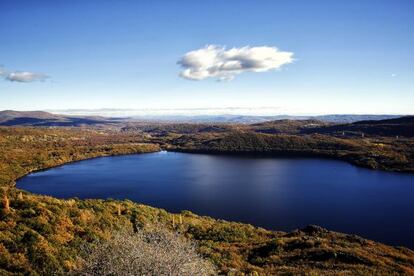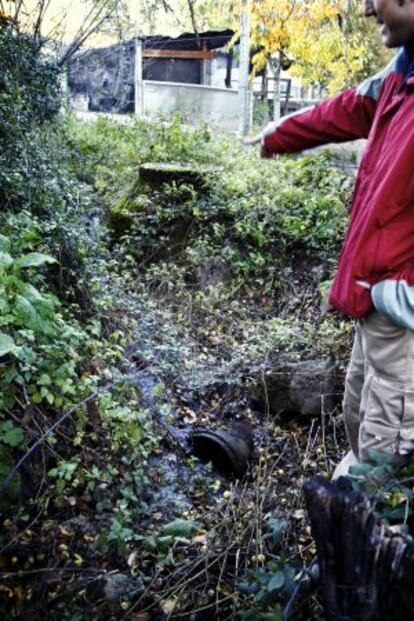Is something murky lurking in Sanabria?
Regional authorities defend good quality of Spain's largest glacial lake Meanwhile, the Civil Guard is investigating sewage dumping


Lake Sanabria's mirror effect, which captured the imagination of early 20th-century writer Miguel de Unamuno, is not leaving those charged with analyzing its waters equally impressed.
The body of water is located inside a natural park in Zamora province, which receives some 700,000 visitors a year. But complaints about sewage being dumped there have raised the alarm about the state of the largest reserve of glacial water in the Iberian peninsula.
The International Biology Station (EBI), a company that runs an eco-tourism project and conducts studies in the area, is warning that conditions in the lake are getting worse, and that the damage will be irreversible in the mid-term. Its conclusions are backed by around 30 scientists, many of whom are renowned experts in the field.
Experts warn that conditions are worsening and may be irreversible
The regional government of Castilla y León says that the quality of its waters is good, and is even getting better. But the image conveyed by this precious lake is very different.
The Civil Guard is investigating the sewage and the state of the water treatment plants around Sanabria. The EBI has filed a complaint with the law enforcement agency's Zamora headquarters, alleging that there is an attempt to cover up the dumping. In September, this same firm filed a suit against the government agencies and the people in charge of controlling this issue.
The natural area in which Sanabria Lake is located is part of the environment protection network Red Natura 2000, and as such it has received between 15 and 20 million euros of European Regional Development Funds (Feder), according to the plaintiffs' calculations. Of that, around six million euros went to building water-treatment plants, whose correct operation is now being questioned. Dumping is prohibited by the European Union in any ecosystem that is part of Red Natura.

EL PAÍS has checked at least three of the alleged dump sites. At 6pm, near the pier of Custa Llago, the main beach at Sanabria Lake, it is difficult to make out the bottom even though the depth here is no more than two meters.
The residents of Ribadelago Nuevo, a hamlet of 107 souls, take the dumping as a regular occurrence. They live right by the lake, and they say that the change in its waters has been noticeable. Last Wednesday there was a residents' meeting scheduled for 6.30pm. Half an hour before that, customers started showing up at the only bar that was open. Pedro, wearing blue worker overalls, a worn black coat and a navy blue woolen hat, orders a beer and talks about the bad design of water treatment in the area. He claims that raw sewage flows directly into the River Tera, barely 200 meters from the lake. He describes the excrement in great detail. "I used a sickle to clear the areas where the dumping takes place," he says. "In the summer the stench is unbearable."
Standing next to him is César, wearing a vest full of pockets. He orders a red Rioja wine and states that "fishing has gone down maybe 70 percent in the last 10 years; now there's hardly any trout."
Everyone was aware of the dumping, but nobody ever said anything"
The mood at the bar gets livelier as around a dozen locals start talking about the comings and goings of the treatment plant technicians and the work that's been carried out in recent days.
"[The filters] used to be full of cobwebs," says one woman who declined to give her name. "Workers would clean them, but if they broke down that wasn't their problem." This woman adds that there had never been so much seaweed in the lake where she goes swimming. "Everyone was aware of the dumping, but nobody ever said anything."
EBI's studies, led by university professor Antonio Guillén, detected an abundance of diatoms, a type of algae that is a herald of poor biodiversity. This diatom boom causes the lake to lose its oligotrophic nature, which consists of clear waters and low nutrients. But the technicians from the government of Castilla y León who are in charge of watching over the lake's environmental health disagree with this verdict.
"The waters remain stable, with a tendency to improve," says José Luis Gutiérrez, who works for the regional government's natural spaces department. According to his data, the water quality has improved through less dumping. "Our work has been validated, and we are not talking about a one-off analysis." This region, which is ruled by the center-right Popular Party (PP), has been taking water samples every month since 1986, and authorities here talk about "spectacular transparency" that lets one see down to a depth of nine meters.
Meanwhile, the engines of the water-treatment plant for Ribadelago Viejo and Ribadelago Nuevo were going at full speed last Wednesday. The Civil Guard had come by to ask questions about the dump sites. The EBI report has taken note of 25 such points over the last 10 years.
Jesús Villasante (PP), mayor of Galende (the administrative center for the hamlets of Ribadelago Viejo and Ribadelago Nuevo), did not respond to queries from EL PAÍS. But during last Friday's celebration of a provincial holiday, he stated that the problem "is not serious." Just in case, though, he said that dumping has been going on for a long time and that he has personally complained about it, although nothing has been done.
Tu suscripción se está usando en otro dispositivo
¿Quieres añadir otro usuario a tu suscripción?
Si continúas leyendo en este dispositivo, no se podrá leer en el otro.
FlechaTu suscripción se está usando en otro dispositivo y solo puedes acceder a EL PAÍS desde un dispositivo a la vez.
Si quieres compartir tu cuenta, cambia tu suscripción a la modalidad Premium, así podrás añadir otro usuario. Cada uno accederá con su propia cuenta de email, lo que os permitirá personalizar vuestra experiencia en EL PAÍS.
¿Tienes una suscripción de empresa? Accede aquí para contratar más cuentas.
En el caso de no saber quién está usando tu cuenta, te recomendamos cambiar tu contraseña aquí.
Si decides continuar compartiendo tu cuenta, este mensaje se mostrará en tu dispositivo y en el de la otra persona que está usando tu cuenta de forma indefinida, afectando a tu experiencia de lectura. Puedes consultar aquí los términos y condiciones de la suscripción digital.
Últimas noticias
The complicated life of Francesca Albanese: A rising figure in Italy but barred from every bank by Trump’s sanctions
Half of Scotland is in the hands of 420 property owners
Pinochet’s victims grapple with José Antonio Kast’s rise in Chile
Reinhard Genzel, Nobel laureate in physics: ‘One-minute videos will never give you the truth’
Most viewed
- Pablo Escobar’s hippos: A serious environmental problem, 40 years on
- Why we lost the habit of sleeping in two segments and how that changed our sense of time
- Charles Dubouloz, mountaineering star, retires at 36 with a farewell tour inspired by Walter Bonatti
- Trump’s obsession with putting his name on everything is unprecedented in the United States
- The Florida Keys tourist paradise is besieged by immigration agents: ‘We’ve never seen anything like this’








































